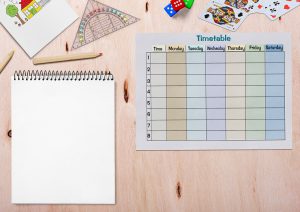We know, you’ve heard it all before: exercising is one of the best things you can do for your body (and your mind). We’ve told you, your doctor has told you, all of the studies known to man have told you, right? So you’re getting your body moving and feeling good, and that’s great! Which means, we certainly don’t want to be the ones to slow your roll, but we were wondering whether there are exercise habits that we can pick up that are actually not so great for us. And science gave us the answer: there are! Fortunately, they’re things you can easily avoid or fix, so let’s take a look at which habits to break now, so you know your exercise regime is doing your body good, and not doing you unwitting harm.
1. Ignoring Steady-State Cardio
Are you a HIIT junkie? Do you love the feeling of getting into zone 4 (we’ll review the heart rate training zones below) when you workout? That type of workout is undeniably great for burning fat and building muscle, but there is something it doesn’t do. It doesn’t help you build your aerobic fitness, or improve your mitochondrial functioning (yes, we’re going to bring you back to your high school biology days). Here’s the thing: training in zone 4 is not going to improve your zone 2 functioning; funnily enough, training in zone 2 improves all zones above it (3-5), but training in higher zones does not improve lower zone fitness.

And why is your aerobic fitness (zone 2) important? According to Howard J. Luks, MD, an orthopedic surgeon and sports medicine specialist, “Not only will Zone 2 heart rate training boost your performance, it just might save your life. After all, your heart is just a muscle. Humans die of very predictable causes. Most of the chronic diseases which will lead to our demise have a common root cause– poor metabolic health due to poor mitochondrial function. Exercising in Zones 1 and 2 will improve your mitochondrial number, function, efficiency, and fitness. Exercising in zone 3 and above will not improve your aerobic (mitochondrial) health.”
He points out that the benefits of zone 2 training include:
- Increases the number of mitochondria
- Increases your mitochondrial efficiency
- Increases your “metabolic flexibility,” or the ability of your mitochondria to utilize fat and glucose as an energy source
- Lowers your resting heart rate
- Decreases blood pressure
- Lowers your risk of injury
- Improves insulin resistance
- Can help you to run/cycle longer
- Improves your resilience and ability to deal with increasing load
- Improves your zone 4,5 function/performance
And in case you need a refresher high school bio lesson (as many of us do!), your mitochondria are the powerhouses of your cells: the healthier they are, the healthier you will be. On the other hand, people with heart disease, dementia, Type 2 diabetes, metabolic syndrome, cancer, etc usually have fewer or “unhealthier” mitochondria.
Ready to add in more zone 2 training? Here’s another refresher, this time on the heart rate training zones:
- Zone 1: Very light intensity, or 50-60% of your max heart rate (see here for calculating your max heart rate)
- Zone 2: Light intensity, or 60-70% of your max heart rate
- Zone 3: Moderate intensity, or 70-80% of your max heart rate
- Zone 4: Hard intensity, or 80-90% of your max heart rate
Zone 2 cardio training can include things like a long, slow jog, a gentler bike ride, or some slow swimming. Just make sure you can speak easily and in full sentences without having to pause – and try to spend a longer time doing these activities than you would if you were doing an intense workout.
2. Doing Too Much, Too Fast, or “Overtraining”
A lot of us don’t get enough exercise, but then again, some of us are doing too much! You could either start out too quickly and do too much, too fast, or, if you’re a more seasoned exercise aficionado, you could be simply doing too much, or overtraining. Overtraining doesn’t feel good, and it can actually be dangerous for your body. The signs to look out for show just how bad doing too much can be for your health:
- Muscle soreness that lasts more than 3 or 4 days
- Suppressed immune system
- Increased injuries
- Constant fatigue, irritability, and low energy
- Getting tired early in your workout
- Hitting performance plateaus, or even seeing a decline in performance
- Depression or anxiety
And it doesn’t stop there. You could find yourself with other physical symptoms, like increased resting heart rate, increased blood pressure, increased basal temperature, gastrointestinal issues like constipation, and sleep disturbances. Women could experience a loss of menstruation or early-onset osteoporosis with consistent overexercising. Men, on the other hand, could experience a decreased sex drive as a result. Anyone who overtrains to an extreme could even find themselves with heart or kidney damage.
Not only that, but those increased injuries we mentioned? You could be looking at things like stress fractures, muscle strains, runner’s knee, joint pain, tendinitis, and bursitis.
The good news is you can reverse the problems that come with overtraining. The first and most important thing to do is rest: take off at least 1-2 weeks from exercising, or until you feel like yourself again (both mentally and physically). While resting, and when you return to working out, make sure to eat well, hydrate, give yourself enough recovery time, get enough sleep, and don’t overdo it! If you still feel the effects of overtraining after 2 weeks, speak to your doctor about any underlying issues that might need to be addressed.

3. Wearing the Wrong Shoes
You might have the best looking pair of sneaks around, and they might look perfect on you no matter what you’re doing, but that doesn’t mean they’re perfect for every activity. Wearing the wrong type of shoe for the activity you’re doing could increase your chance of injury, so make sure you know what type of shoe works best for what you’re doing. For example, dance cardio requires a more flexible shoe, while weight training requires a flatter, more rigid sole. You should also ease into a new pair of footwear gradually; don’t go for a 5-mile run in those new barefoot shoes, for example! And remember to replace your shoes every 350-500 miles, or every 3-6 months (and, ladies, while you’re at it, replace your sports bras at the same time: their elasticity diminishes over time, which can lead to breast discomfort and even sagging).
4. Using Bad Form
Picking up some weights? Great: weight training will help you to build muscles and burn fat, and keep your body generally healthy, but only if you do it with proper form! Not only will using proper form keep you focused and help you get the most out of your movements, but it will also help you avoid injuries like sprains, strains, joint issues, and fractures. If you’re new to strength training, be sure to ask an expert about proper form, and remember the basics (things like knees should never go past your toes when doing lunges, for example).
5. Not Warming Up or Cooling Down
Sure, warm-ups and cool-downs add precious time to your workouts, but they are important, according to experts. They say that warming up before your workout helps you to gradually increase your heart rate and breathing to a level that will be able to meet the demands of the exercise you’re about to do; if you start exercising at a strenuous level without warming up first, you will place unnecessary stress on your heart and lungs. Studies actually back this up: in one, the results showed that 70% of subjects in the study had abnormal ECG readings after jumping right into an intense workout because of the inadequate oxygen supplied to the heart. Essentially, their hearts weren’t ready to perform at the high rates required for the intense exercises.
And that nice, gentle cool down at the end of your workout? Also worth the time, according to experts. Not only can cooling down clear lactic acid out of your system, helping to improve recovery and reduce soreness, but it can also help keep you safe. If you stop exercising abruptly without cooling down, your muscles will suddenly stop contracting vigorously, which can cause blood to pool in the lower extremities of your body, leaving your blood without as much pressure to be pumped back to the heart and brain. As a result, you could end up feeling dizzy and lightheaded, and you could even faint.
So, as you plan your next workout, make sure you give yourself an extra 10 minutes on either side of it to do some gentle cardio and dynamic stretching (like arm and leg circles) as a warmup, and some gentle cardio and light stretching as a cool down.
6. Cutting Out Carbs Completely
Ditching the carbs has been all the rage for a while now, but being carb-free is not necessarily all it’s cracked up to be. Experts tell us we actually need carbs for both aerobic and anaerobic exercise, since your body uses muscle glycogen as a primary fuel source when you’re working out. That means a depletion of muscle glycogen will actually result in muscle weakness – not exactly what you want when you’re working out. If you’re feeling a little carb-phobic, your best bet is to cut out those refined carbs that don’t do anything for your body anyway. You know the ones: refined sugars and heavily processed foods. But keep the good carbs: fruits, veggies, and whole grains.
We’ve said it before and we’ll say it again: exercising is great for you! You just have to do it right, and that’s not so hard. So get moving and treat your body right with the tips above – and let us know if any of the above sounds familiar, if you’re guilty of any bad fitness habits (and how you broke them), or if we left anything out. We want to hear from you!



















